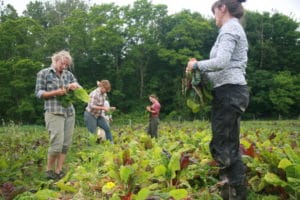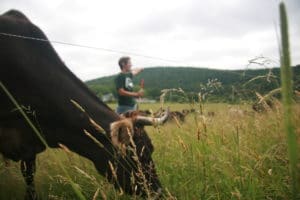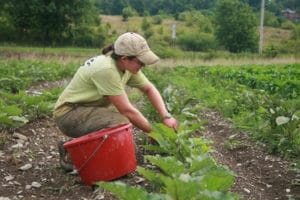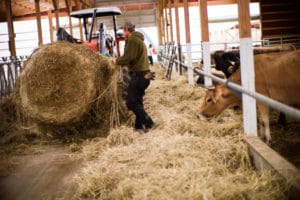Growing the Next Generation of Farmers in the Hudson Valley
“The dirty secret of the food movement is that the much-celebrated small-scale farmer isn’t making a living. After the tools are put away, we head out to second and third jobs to keep our farms afloat. Ninety-one percent of all farm households rely on multiple sources of income… health care, paying for our kids’ college, preparing for retirement? Not happening…..” Sunday Review, NY Times: “Don’t Let Your Children Grow Up to Be Farmers”

Hawthorne Valley Farm apprentices harvesting Swiss Chard for the weekly CSA. Photo credit: Michele Kowalski
“Let your children grow up to be farmers..let them know what it is like to be free from fluorescent lights and laser pointer meetings. Let them challenge themselves to be forever resourceful and endlessly clever. Let them whistle and sing loud as they like without getting called into an office for “disturbing the workforce.” Let them commute down a winding path with birdsong instead of a freeway’s constant growl. Let them be bold…… Let them learn what real work is. Let them find happiness in the understanding that success and wealth are not the same thing. Let them skip the fancy wedding. Let them forget four years of unused college. Let them go. Let them go home.” The Huffington Post: “Let Your Children Grow Up to Be Farmers”
We do live in extraordinary times – so many challenges – so many chances to dig deep, to discover our core values and to try to live by them. As the above quotes suggest, it is not always easy to reconcile many of our strongly held beliefs in small to mid-scale sustainable agriculture with the hard core financial facts. As someone who works daily with aspiring, idealistic young farmers, these two quotes are frustrating, invigorating, and hit the nail right on its economic head. At the Institute for Mindful Agriculture we have been observing what we are calling the “emerging real food economy” for the past 20 years. It continues to grow and thrive in the Hudson Valley and yet, paradoxically, many small farmers also continue to struggle to survive. The need to grow the next generation of farmers into a strong supportive network that will evolve a “Hudson Valley food shed” requires us to have a long hard look at the economic challenges and farming values presented above.
Some History
Family farms have existed along the Hudson for the past 300 years. Dairying and beef cattle, fruit and vegetable farming, haymaking, grain production, sheep farming, have all had their time and place, county by county within the ecological reality of our beautiful river valley. And those farms helped to shape and support a vibrant rural culture that included writers, painters and musicians, where both economic and cultural activity related itself right back to the endpoint of the Hudson River in New York City. The urban-rural connection is not a dream or a myth, but has been a long standing reality for us. But the advent of post World War II industrial agriculture caused a steady decline in the number of family farms in the Hudson Valley and some of our major agricultural products moved to other parts of the country – dairying to the mid-west, apple production to California, etc.

A Hawthorne Valley Farm livestock apprentice in the pasture with the dairy herd. Photo credit: Michele Kowalski
From the mid 1970’s to the mid 1990’s the rise of small organic farms, the food co-op movement, and a renewed interest in local farmers’ markets signaled the beginning of something new and a little different for the Hudson Valley. Many of the up and coming farmers, retailers and food entrepreneurs were former urban dwellers, sometimes college grads taking refuge from the increasingly destructive political times. Many of us were idealistic, ambitious and given to working collaboratively. Hawthorne Valley Farm was at the vanguard of this early history. We were one of the first farms at the Union Square market with our products; we started training interns on our farm in 1974 and also began our farm based education programs for children during that time. CSA’s took hold in the United States during these years as well. By the late 1990’s this “phenomenon” had grown into an “organic food movement” including biodynamic farms as well. As farmers and farmer educators we found ourselves in a strong supportive network that included peer-to-peer learning, sharing of knowledge, skills, equipment, and sometimes even our products as we grew our marketing capabilities. The CRAFT network (Collaborative Regional Alliance for Farmer Training) was born as an attempt by Columbia County organic and BD farmers to offer our apprentices more complete and robust learning opportunities as the next generation of growers and livestock farmers began to populate the Hudson Valley.
We were helped in our efforts by an ever more aware population of “eaters”. Mothers concerned for food safety for their children, individuals who responded to health needs and those with ecological and environmental awareness, were some of the consumers, who all helped to grow this movement.
In 2006 a watershed moment occurred. “The Omnivore’s Dilemma” by Michael Pollan was published and after it many other books and films highlighted the perils of industrial farming. An ever greater awakened public began to be interested in farms and food. Consumers started to demand better foods in their restaurants. Diet and health were finally clearly linked. Organic growers were already delivering to restaurants up and down the Hudson Valley when the the farm to table movement emerged and opened many new markets. Once the restaurants got involved an “agri-tourism scene” developed. At the same time, the next generation of young people became interested in food – and in contributing to what was clearly becoming a Hudson Valley “food shed.” And that is where we find ourselves today.
A Maturing Food Movement and a Long Way To Go
“This all sounds great”… you will say… “so what’s the problem?” Well, the problem is that indeed – as the NY Times op ed piece suggests – with all this wonderful growth and positive contributions from all parts of the food “value chain” – many small scale sustainable farmers still find themselves struggling financially. They often work long hours in the field and then move on to work long hours directly marketing their food with little personal security . And yet they continue to want to farm, to be part of this growing “food movement” because their deepest held values spur them on. Where are the “stuck” points, the “gaps” in our current efforts to provide wholesome and nutritious food locally and regionally and to participate in a cultural “renaissance” with food and farming at its foundation for the Hudson Valley food shed?
- Our farmers are lacking the business skills to scale up their businesses.
- They are often carrying tremendous debt from their university experiences and are afraid of taking financial risks
- They lack capital to grow their businesses
- They lack access to land
- They are concerned about markets
These challenges are real and are being addressed by those of us who consider ourselves service providers to aspiring farmers. Programs such as the Grow NYC “Farm Roots” Program, Cornell University’s “Small Farms Program” , Hawthorne Valley’s “Farm Beginnings Program,” Stone Barns’ Young Farmer Conference, the yearly NOFA NY conferences, Glynwood’s Incubator Program, (among many others) are all working collaboratively to help young farmers gain skills to grow their farms and become successful entrepreneurs.
Other service providers such as Northeast Farm Access, Columbia Land Conservancy and American Farmland Trust’s land link programs, Dirt Capital Partners, The Carrot Project, Slow Money, and the USDA Farm Service Agency are dealing with land access and questions of capitalization for new farmers.
At this point I would like to focus on one particular “gap” or “stuck place” in our food system that poses an increasing challenge to the next generation of small to mid scale farmers:
- How does our food get to us?
- What distribution systems are currently in place?
- Do those systems need to evolve and develop in the same way as our small to mid-size farms have been re-shaping themselves over the past 20 years?
How can solving questions of distribution help the needs of the next generation of small farmers?
Food Hubs Throughout the Hudson Valley
Most small scale farmers like to direct market. CSA’s offer a chance to build community and the farmer receives the full share price without having to first sell his/her produce through an intermediary. Farmers like markets for the same reasons. However, driving a truck for hours upon hours to deliver shares, or needing to attend 10 markets a week in order to bring in an adequate income is a grueling proposition. Such challenges greatly interfere with a farmer’s quality of life when added to the 60-70 hours per week spent in actual farm production. In addition, new farmers are often not allowed into existing markets if they are offering product already present in the marketplace and CSA shareholders are becoming harder to find. As the “emerging real food economy” continues to grow, we are will certainly be offered the possibility for continuing consumer education and community building. Hopefully this will translate into continued growth of farmer’s markets and CSAs.
There still remains the unexplored area of wholesaling for many small farmers. The Local Economies Project in Ulster County is pioneering a Farm Hub/Food Hub project that includes a training program for farmers interested in learning how to farm for the wholesale markets and aggregating food for the larger institutions such as hospitals and schools. For this kind of effort, larger amounts of acreage need to be in production and a scaling up of all systems from planting to post harvest handling of crops are being looked at.
This doesn’t solve the problem of price for the small grower. Wholesale prices are just that – a price that will go to the farmer that is lower than a retail price because the food will need to be marked up by a distributor and then by a retailer before it reaches the consumer. On a farm enterprise with diverse marketing venues, it would be very possible to spare some acres out for crops or livestock enterprises if the price were right. How to guarantee a fair price for the farmer and a reasonable price for the consumer when you are in the wholesale market?
Enter two independent and fascinating projects. The first is the Corbin Hill Food Project initiated by social justice food activist Dennis Derryk. The second is “Farmers To You” – developed by food entrepreneurs Greg Georgaklis and his wife Eva Cahill. Each of these food entrepreneurs has developed farmer networks – Dennis in the upper Hudson Valley and Greg and Eva in Vermont and connecting them with either NYC or Boston families. They aggregate product in their warehouses and send it off to pre-determined pick-up sites with an option for home delivery in the case of “Farmers To You.” They DO NOT buy and sell product. They are not distributors. They are facilitators. They take a set fee to run their businesses. They are committed to making sure that farmers get the best prices possible for their products while also making sure that families can afford the food. And they work to insure that farmers and families connect to build strong farmer/consumer networks and a sense of community. Dennis, Greg and Eva are building food hubs. We need more of such food hubs and the Institute for Mindful Agriculture will continue to do its best to promote such projects as part of the emerging, real food economy.
Rachel Schneider is co-director of the Institute for Mindful Agriculture and Director of the Hawthorne Valley Farm Place Based Learning Center which focuses on farm based educational programming for children and families and professional training in the vocation of agriculture. She can be reached at rachel@hawthornevalleyfarm.org or by phone at 518-672-7500 x 236.
For more information on how the Institute for Mindful Agriculture is working to reshape agricultural theory and practice, visit www.instituteformindfulagriculture.org




I met Rachel at AASS meeting last week and we agreed to get in contact. I cannot find her email or phone. I am Judith Fitzpatrick who had the MicroBiometerTM test.